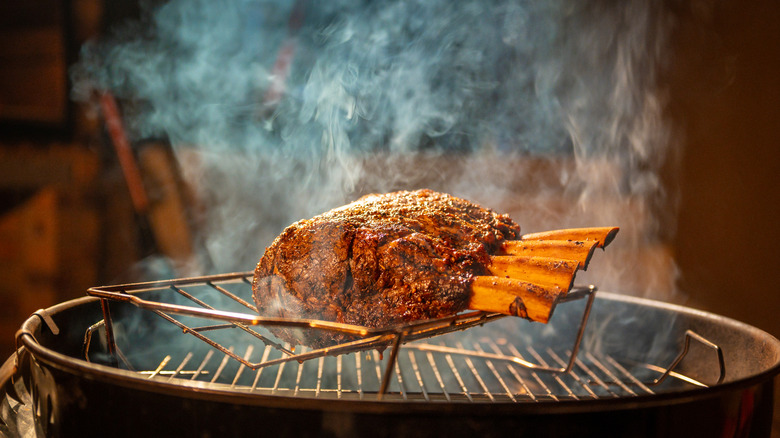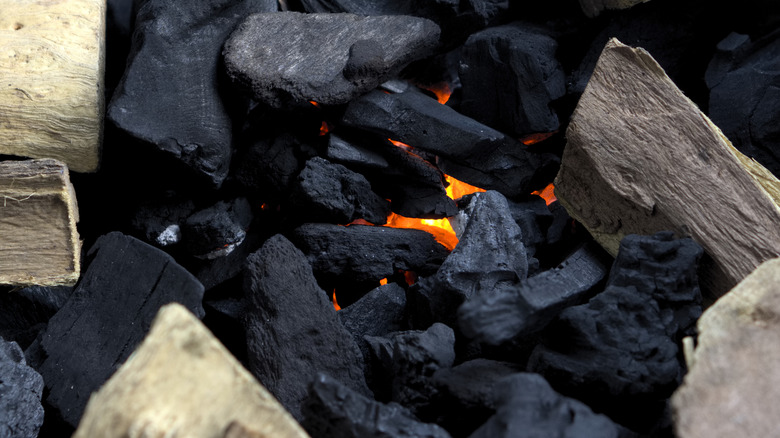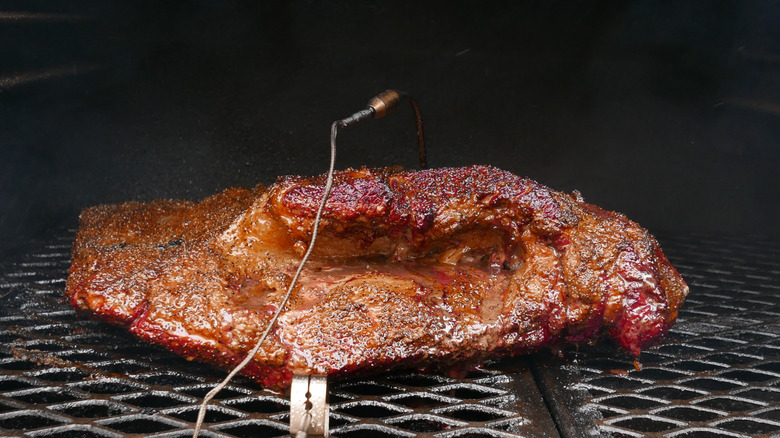The Key To Keeping The Fire On Your Charcoal Grill Alive All Night Long
We may receive a commission on purchases made from links.
The difference between grilling and barbecuing is that the former is usually a quick process, whereas the latter takes a long, long time. If you're smoking a large cut of meat like a brisket, it might need to be cooked overnight. No matter whether it's coffee, Red Bull, or straight shots of store-bought cold brew fueling your midnight fire watch, Scott Thomas, the Original Grillin' Fool and owner of The Grillin' Fools blog, says that regulating the grill's airflow is key to keeping the flame burning.
"Vent management is vital to fire management. If the fire is given too much air, it will run too hot and burn out too fast," he explains. The top vent, he says, should be open anywhere between ¼ inch and one inch, depending on the grill. (Check your instruction manual or YouTube videos if you, unlike Thomas, lack the necessary experience to pinpoint this.) Once it's done, though, you can just let it be. "It's the bottom vent, the one near the fire, that I adjust as necessary throughout the cook session. Again, this takes some practice, so I can't explain where it needs to be on every grill," Thomas tells The Takeout.
If your grill is new, you'll probably need to do an initial burn-in where you heat it without any food inside and run it for up to an hour at a temperature between 350 and 400 degrees. Thomas suggests using this time to check where the vents are and compare this to the temperature shown on a thermometer, so you can get some sense of how wide you'll need to open them to maintain the desired heat level.
A low-tech method to keep the fire going
If you're feeling dubious about your ability to adjust the grill vents to the perfect placement, Scott Thomas offers another option that may make for easier temperature regulation. He calls it the "snake method," and says it starts by piling a long, low mound of charcoal around the outside edge of the grill. You don't want to close the loop, however. "Think of a C pattern," Thomas advises.
Once you've arranged the charcoal to your satisfaction, it's time to place the wood that you'll be using for smoking. (Hickory is the best choice for brisket, but applewood, mesquite, and pecan are solid options for other meats.) Put a piece of it on the charcoal pile every few inches. According to Thomas, "The charcoal will burn down the length of the pile like a slow-moving snake, lighting the smoke wood as the fire reaches that section. It is a magical way to keep a fire lit for hours and hours and keep the temps constant without having to add any charcoal or smoke wood."
How to monitor grill temperature
In addition to making sure your grill fire doesn't go out during the night, you'll also need to keep an eye on the temperature to make sure it's not too low (the USDA recommends a minimum smoker temperature of 225 to avoid foodborne illness) or too high (overcooked meat can be dry and tough). As Scott Thomas points out, though, "We don't turn a dial on most grills to 425 degrees Fahrenheit and it stays right there for hours. In the kitchen, there's no wind, humidity, rain, snow, direct sunlight, etc. Basically, cooking outside brings a lot of variables to the process we don't have inside."
Thomas does note that most charcoal grills have some type of built-in thermometer in the lid, but says it probably won't be accurate since it's located too high above the cooking surface. He recommends testing it against a thermometer placed directly on the grill grates, saying, "If the built-in thermometer shows 400 degrees Fahrenheit and my probe thermometer at the grill grate shows 430 degrees Fahrenheit, I know that the built-in thermometer is under-reporting the temp by 30 degrees."
He also floats the idea of ignoring the lid thermometer altogether and investing in a thermometer with more than one probe, such as the iProbe digital wireless meat thermometer. The benefit of having multiple probes, he explains, is that "one goes into the meat and one is placed at the grill grate. One shows the internal temp of the protein, and one shows the ambient temp in the grill."


